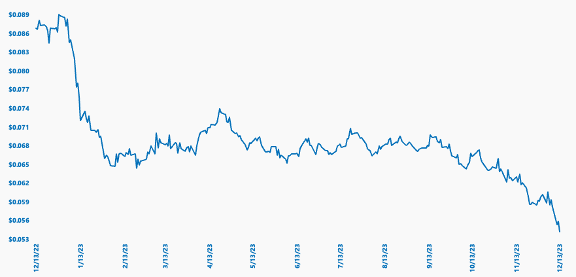Energy Procurement | December 15, 2023
The U.S. Energy Market 2023: A Year in Review
Throughout 2022, the U.S. energy market experienced significant fluctuations that had a profound impact on the start of 2023. The primary trigger was Russia’s decision to curtail its gas supply to Europe, a response to the economic sanctions imposed by Western countries due to the ongoing war. Although the U.S. doesn’t directly rely on Russia for its gas supply, this decision tightened the global supply of natural gas, causing reverberations in energy markets worldwide, including the U.S.
Simultaneously, the U.S. emerged as the world’s largest exporter of Liquefied Natural Gas (LNG) in 2022. This development led to an increased demand for natural gas, which in turn, resulted in a rise in domestic gas prices. While some studies have minimized the impact on domestic prices, the sensitivity of natural gas consumption in the electric power sector to changes in U.S. LNG export volumes is undeniable.
The potential for price increases, dependent on the unpredictable LNG price case, poses a looming threat. Therefore, while the current repercussions of LNG exports on electricity prices are modest, they have the potential to escalate due to the complex interplay of global market dynamics and domestic energy policies. This situation highlights the urgent need for strategic planning and intervention to prevent a potential crisis in the U.S. energy sector.
The situation was further exacerbated by meteorological forecasts predicting an exceptionally cold winter worldwide. These forecasts led to a rally in U.S. energy markets as suppliers and consumers braced for a potential surge in demand. The stage was set for a tumultuous winter in the U.S. energy markets.
However, contrary to expectations, the winter turned out to be one of the warmest on record globally. This unexpected turn of events had a profound impact on the U.S. energy markets. The anticipated weather-driven price events failed to materialize, leading to a sharp decline in future prices. By February, future prices had reached their lowest points, marking a dramatic shift in the market dynamics.
Since then, future prices have largely remained low across all major U.S. markets. This trend has held steady, with one notable exception - the Electric Reliability Council of Texas (ERCOT) electricity market. ERCOT experienced a spike during the volatile summer months, reaching 52-week highs. This spike was attributed to various challenges, underscoring the unique dynamics of the ERCOT market.
As we moved into the latter part of the year, prices declined slightly further. In November, 52-week lows were hit in ISO New England (ISO-NE) and the Pennsylvania-New Jersey-Maryland Interconnection (PJM), two major U.S. energy markets. These developments marked a new phase in the U.S. energy markets, capping off a year of unexpected twists and turns.
The graphs below show the price movement of Calendar Year 2024 Energy Price over the past 52 weeks.
ISO-NE Internal Hub ATC DA Wholesale Calendar Year 2024
Week to Week Fluctuation ($/kWh)

PJM Western Hub ATC DA Wholesale Calendar Year 2024
Week-to-Week Fluctuation ($/kWh)
ERCOT Houston Load Zone ATC RT Wholesale Calendar Year 2024
Week-to-Week Fluctuation ($/kWh)
Algonquin Wholesale Calendar Year 2024
Week to Week Fluctuation ($/Therm)
TETCO-M3 Wholesale Calendar Year 2024
Week to Week Fluctuation ($/Therm)
Houston Ship Channel Wholesale Calendar Year 2024
Week to Week Fluctuation ($/Therm)
As you can see, the past year has been a rollercoaster ride for the U.S. energy market. From the tightening of global gas supplies to unexpected weather patterns and market-specific challenges, 2023 has been a year of significant fluctuations. As we look ahead, these developments serve as a stark reminder of the volatility inherent in the U.S. energy markets and the need for robust strategies to navigate these uncertainties.
The U.S. energy market's journey through 2023 serves as a reminder of the complex interplay of supply, demand, and external factors like weather patterns. It underscores the importance of staying agile and informed in an ever-changing market landscape. As we move forward, the lessons from this past year will undoubtedly continue to shape strategies and decisions in the U.S. energy markets.
Going into 2024, the US energy market could be influenced by several world events. The anticipated growth in global energy consumption, particularly in Asia, could put pressure on oil and gas prices and increase demand for renewable energy. Geopolitical risks, including ongoing wars, could threaten global oil supplies and affect the stability of energy supply chains. Regional variations in natural gas production, transportation, storage, consumption, and trading across the US could also impact natural gas prices. It’s crucial to stay informed about these and other potential developments in the energy sector.
As always, we are here to keep you updated and answer any questions you may have.
Related Posts
Discover more content and insights from Mantis Innovation

Meeting the Demand: The Impact of Data Centers on Energy Infrastructure
The Explosion of Data Centers Data centers have been a major topic of discussion in the energy industry for several years due to their high energy consumption. With aggressive expansion expected in

The Cost of Inaction: Why Businesses Should Act Now on Energy Efficiency
In today's fast-paced business environment, the financial and operational losses businesses incur by delaying energy efficiency improvements, the "cost of inaction," is more relevant than ever.

Navigating Energy Procurement: Strategies to Manage Risk
When procuring energy for your commercial business, it can be difficult to weigh the risks associated with buying strategies. How do you know your procurement strategy is the right one? How

6 Facts about Energy Services in Efficiency Projects
As a nationwide firm with design/build capabilities, we identify, design, and deliver efficiency projects for clients across the United States. These projects are rooted in several core energy